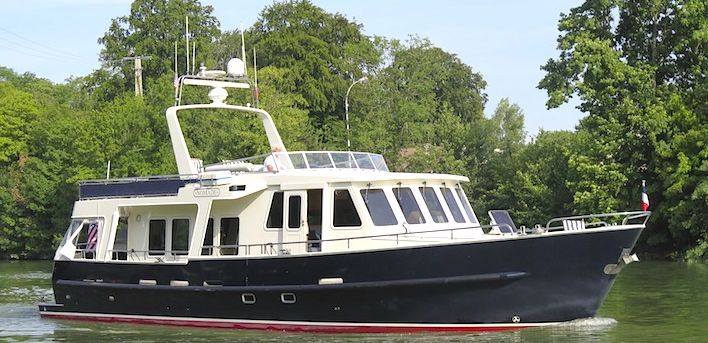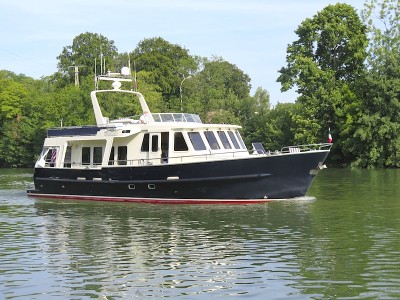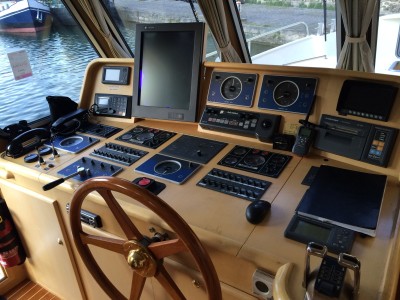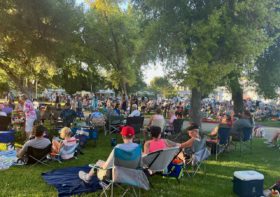Channel Dancers

Note from Lynne: After a year of planning, we were able to coordinate a meeting with Mary webb and Howard Walker in Paris. They invited us to enjoy cocktails aboard “Nomade” when she was tied up at Port Arsenal on the Seine for a few days. It was a spectacularly enjoyable afternoon, and their story about crossing the English Channel was so exciting that I asked her to write the first guest blog for Home Free Adventures. She did a fabulous job. Hang on to your life ring!

Howard and Mary Webb Walker were enjoying a great lifestyle in Florida when they decided to sell everything and plunge into a new adventure. The Walkers bought a motor yacht in Europe which serves as their only home and their means for exploring the European inland waterways and seas. This is their second year on “Nomade,” and they decided to cross the English Channel to celebrate Howard’s birthday in London.
Channel Dancers
Mary Webb Walker
The early morning fog that completely obliterated the lighthouse at the end of the breakwater was slowly beginning to clear in the Port of Dunkirk on the northern coast of France. That glimmer of hope combined with our giddy sense of anticipation were the ingredients for a potentially regrettable decision.

We’d been moored in Dunkirk for two days, awaiting a weather window for our first English Channel crossing on “Nomade,” our 57-foot Dutch steel yacht trawler that we call home. We had pushed hard, coming south from Amsterdam through busy canals and down the big Dutch rivers, then across the mighty Scheldt estuary into the port of Zeebrugge, Belgium before arriving in Dunkirk.
Our 56-mile haul across the Channel to Ramsgate on England’s south coast would be our first venture into the open sea, out of sight of land. Our previous trips had been limited to canal and river cruising, so this was a new challenge. Thinking about crossing the world’s busiest shipping lanes on our very first seagoing adventure was making our adrenaline start to pump.
Among other scary details, there was the racing tide to consider. It can create a rise and fall of over 20 feet in that part of France. The trick was to time our departure just right so that the tide flowed from behind, adding several knots to our speed, carrying us to the first turning point on our course at exactly the best moment. With our big adventure in sight, we wanted to get out of the starting gate ASAP so that we didn’t have any more time to let the ‘what ifs’ creep in.
After pouring over tide tables and rechecking calculations, triple checking five different weather reports in French and in English for wind, wave, temperature, precipitation, and visibility, we picked our go date. All was looking good until we peeked out the hatch at 7 AM. The dense fog waved my hair in about 10 seconds.
Decision time. Should we stay or should we go? This was where safety considerations had to trump our best laid plans, where objectivity had to overcome anticipation, where we definitely didn’t want to make a regrettable decision, but we needed to get moving before another bout of bad weather delayed us. So, after weighing all the intel, we finally decided to go for it. I thought, “If my cautious husband/captain is ready, then I’m rarin’, too.”
We had just agreed that we would take the plunge when a surprise guest appeared in the engine room. I was standing on the dock ready to loose lines when Howard suddenly popped from below decks, gingerly holding a bundle of dish towels away from his body and heading for the edge of the dock making that ‘whoa’ sound.
A foot-long, slithering, slimy eel had gotten sucked into the engine’s water intake filter. After eyeballing each other for a few stunned seconds, Howard had started chasing Monsieur Eel around the engine room (headroom four feet) on his hands and knees in what must have been a hilarious but not-funny-at-the-time YouTube-worthy scene. He finally managed to capture it, creep up the steps, and get it back into the sea. This eel was not happy and had the nerve to try to bite the hands that were saving its life, but into the water it went with no harm done to the rescuer or the eel.
With that bit of excitement behind us, we finally loosed lines at 11AM and plowed into a tide that was now head-on in cold, foggy weather. At least it wasn’t raining. This is when the adrenaline truly kicked in. We were finally doing it. We were crossing the Channel, that unrelenting body of water that separates southern England from Northern France, and the Atlantic Ocean from the North Sea and has served as the scene for many a lip-biting film.

The heaviest fog rolled in just at the most challenging and dangerous point – as we were approaching the shipping lanes or TSS, a very British term for Traffic Separation Scheme. This is the Channel’s version of the New Jersey Turnpike or 405 LA Freeway, complete with median.You can’t just cruise at leisure across those five-mile wide sections of water, which, by the way, have no signposts saying, “You Are Now Entering the TSS. Proceed With Caution.” You have to identify them accurately via chart and cross at 90-degree angles or you could be a) mowed down, b) fined thousands of euros, and/or c) intercepted and escorted to port for who knows how many lashes, license revocations, and (horror of horrors), a British tongue-lashing. Helicopters hovered, their crews gleefully anticipating changing the fate of some poor green pleasure boater crossing at an 89-degree angle.
Dover Coast Guard broadcasts at this point were indicating only two cable lengths of visibility. For you non-nautical readers, that’s the equivalent of driving through a blizzard blindfolded. Welcome to sailing in English pea soup while surrounded by ships the size of three football fields, each transporting what looked like small cities. Many were carrying dangerous cargo that was thankfully described in code to Dover Coast Guard to save us from being horrified.
Fortunately, our boat has amazing radar and AIS, which stands for Automatic Identification System. AIS reports everything about a ship short of how the captain takes his/her coffee. Just as importantly, it allows other ships to know you’re there. We could therefore anticipate what was approaching and avoid playing mid-Channel bumper boats, since the big boys have no chance of stopping quickly.
While Howard carefully steered through the northbound TSS lane from the flybridge, I was glued below to the radar screen in the wheelhouse, shouting positions of approaching ships. At one point, I happily reported that there were no ships at all. Two minutes later, I counted 24. Only when we got close enough to see through the fog did we realize that they were anchored in the “median,” waiting for the tide to turn in their favor.

Just when we thought we were safe, our heart rates returning to normal in that median, a bit of euphoria began kicking in. It was time to stick our bow out of the median and cross the southbound lane, which were indeed looking like the LA 405 in rush hour That’s when the monster materialized.
We were almost home free when a dot appeared high on the edge of the radar screen at one o’clock. Based on the speeds at which the other “dots” we had encountered traveled, it seemed certain that we would exit the lane before this blip became a real ship.
Not happening! This one flew down the screen at a quadrant a minute. My normally calm voice started sounding more urgent as that dot accelerated. Howard threw the Nomade into reverse to slow our forward motion. As my shouts got louder, he executed a 90-degree turn to steer a course parallel to the flying dot. (Glad no helicopters were watching but surely collision avoidance takes precedence over their right angle crossing rule). Then she appeared out of the mist no more than 50 yards away, a close call with a ship that size. At almost 1000 feet long, MSC Yokohama was the size of the city of Yokohama from our perspective. Howard took a deep breath and angled toward her stern to enable us to resume right-angle crossing as quickly as possible. But the Coast Guard had warned us not to approach ships’ sterns too closely, or it could appear to their radar monitors that we may be catching a drug package tossed from the ship. Being intercepted for being drug smugglers was the last thing we needed, so instead of aiming right at the stern, we aimed a few yards behind it. Was our parting ever sweet relief as the Yokohama steamed off into the fog bank.
Finally, at the six-and-a-half hour mark, we emerged from the shipping lanes. Now we could jump up and down in sheer relief and jubilation! Almost.
At that very moment, just to make life interesting, the wind kicked up and the waves climbed high. We looked out on a sea of rollicking white caps. Our final hour-and-a half into Ramsgate was no picnic, as we had removed our stabilizers, wonderful inventions that keep the boat flat in rolling seas. We would be cruising in France in a few weeks and didn’t want to mangle them in those narrow canals. Naturally we had assumed we could cross the Channel on a calm, sunny day so stabilizers wouldn’t be necessary. Without them we were rocking and rolling from side to side, then bow to stern, hanging onto the rails on the flybridge to keep from being tossed around as the swell height reached around eight feet.If this had happened a week before, we might have been terrified, but we were so ecstatic about clearing the shipping lanes that being on spin cycle was no big deal.
We definitely experienced divine intervention that crossing day, and along with Captain Howard’s cool head and amazing skills we made it unscathed. . We safely docked on Ramsgate’s floating pontoon under the most beautiful, surprising blue sky and welcoming sun. Who cared if it was 38 degrees Fahrenheit. We’d done it. Time to pop open the bubbly, then go share our tale at the local yacht club, where the ships in the lanes no doubt would grow bigger and closer with each telling.
We won’t think about crossing back to France for another three weeks or so. For now, we are the Channel Dancers.




Wow! You are brave souls! By the date on your post, you must be back in France again and hope you had smoother sailing on the way back.
Just a quick Google to find out where you landed and there you are! Glad to hear that you’d taken the plunge and are having a great time. Best wishes! Bon voyage!
Boy, I’d really like a narrative of the return trip. Was it any easier?
I can’t imagine how large those ships, like the MSC Yokohama, are when seeing them so close by. Shockingly huge. What came to my mind was the 1980s Atari game called Frogger. Nomade as Frogger.
Very exciting! And I’m sure it was even more heart-stopping in real life, but what a great story, well told! Thanks for sharing, Lynne and Mary.
Just reading about your adventure makes my hear beat faster! Glad you had a happy ending and got to tell the tale!
That was quite an exhilarating read! Great post!
Geez! My heart was in my throat just reading that. How brave to set off in that fog. I bet that you were exhausted when you finally made land again! Let the adrenaline calm down. Thanks for sharing!
How exciting it must have been and even more so when it was over! Brave souls I say!
So happy to read about our friends Mary Webb and Howard and their exciting and “scary” adventure. We’ re sure they are happy to be back in calmer waters. Bravo!
My husband and I have talked about doing a European continent river and canal season on a boat, taking biking day trips as we crawl through the countryside. What a great story. Would love to hear more about life on your floating home. Thanks for sharing Lynne!
Hi Mary and Howard,
Our dear friends, the Silverman’s, can attest to your many expert navigational skills in wonderful calmer times along the Seine and the canals of Amsterdam. This crossing must have been an unbelievable, harrowing time! Well done both of you! Loved reading this well written account! I’m assuming the return trip went much smoother. Whew.
Thanks for sharing Lynne. Great writing Mary….enjoy Europe
Wow, brave souls! Well done!
What a fun read! Exciting tale, great storytelling 🙂
Happy sailings and God speed. A wonderful tale to tell!